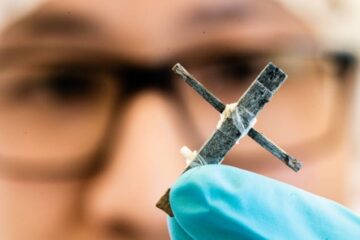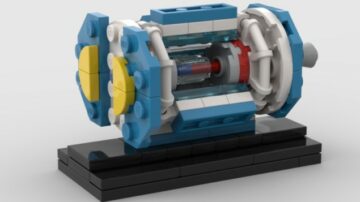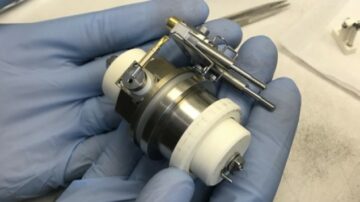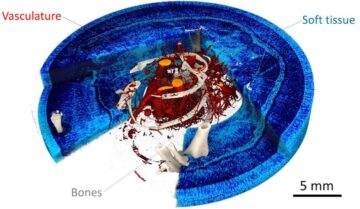James McKenzie explains why magnetism is so important for physics-based businesses

In 2022 I stood for election to the magnetism group of the Institute of Physics (IOP) as I always think the best way to be involved in anything is simply to get stuck in. I’d only joined the group the year before after starting to work at a company specializing in permanent magnetic materials. Despite not knowing much about the group, I was – to my surprise – elected.
The magnetism group is one of the IOP’s larger special-interest groups and, among other things, runs a successful and widely attended annual conference, which this year was held in Manchester in April. The meeting covered topics stretching from spintronics, 2D physics, domain walls and dynamics to vortices, skyrmions, topological physics and intelligent computing. It also spanned a wide range of materials from biological and organic systems to spin ices, superconductors and magnetocalorics.
But the IOP’s magnetism group isn’t the only UK outfit involved in this field: there’s also the UK Magnetics Society (UKMagSoc), of which the company I work for is a corporate member. UKMagSoc’s activities overlap to some extent with those of the IOP, but the society is more focused on the application and commercialization of magnets, such as electrical machines, instruments and hard disks. The society does, though, have individual members as well – in fact, in June I attended a joint IOP/MagSoc event at the IOP’s headquarters in London, where speakers spelled out the challenges over the next five or 10 years in a range of magnetic materials and devices.
Future challenges
For a newcomer like myself, the meeting was a really helpful overview of magnetics and I finally found out from a talk by Thorsten Hesjedal from the University of Oxford what a skyrmion really is. It’s a whirling, nanometre-sized topological defect in a thin magnetic film that could provide a new form of computer memory. Skyrmions could, I learned, be particularly useful out in space where conventional computer memory can easily get corrupted by cosmic radiation.
There were also some excellent talks of direct interest to my day job on various aspects of motor design and electrical machines by John Reeve from drive manufacturer FluxSys Ltd, by Dean Evans of motor and generator firm NEMA, and by Juliette Soulard of the Warwick Manufacturing Group. Particularly interesting to me was a lecture by Robert Hicken, a condensed-matter physicist from the University of Exeter. He examined the challenges of keeping up with the ever-increasing demand for data storage, a topic I reported on in December 2020.
Now you’ve certainly heard of Moore’s law, which – as I mentioned in another recent article – states that the number of transistors on a microchip doubles about every two months. It is named in honour of the late Gordon Moore, the co-founder of Intel who came up with the concept in 1965. However, Hicken introduced a related concept that was new to me, which is that the density of data storage on magnetic media (such as hard drives) should increase at a rate of about 40% per year.
The demand for data storage will certainly rise in the long term and companies like Seagate, Toshiba and Western Digital will be doing all they can meet the huge demand
Known as “Kryder’s law”, it’s named after Mark Kryder — a former chief technology officer at disk-drive manufacturer Seagate. Kryder, who has a PhD in physics, first mentioned the notion in an article in Scientific American in 2005. Sadly, Kryder’s law has been rather less successful than Moore’s law because the growth in storage density on magnetic materials rose by only 15% in the five years ending in 2014.
Even if Kryder’s bold predicition didn’t hold true, the demand for data storage will certainly rise in the long term and companies like Seagate, Toshiba and Western Digital – who together make 80% of all hard-disk drives (HDDs) in the world – will be doing all they can meet the huge demand. Worth $35bn per year in 2021 according to a report from Future Market Insights, the data-storage market is set to grow to $80bn by 2029.
A staggering 259 million HDDs were shipped in 2021, with most going into data centres. With 44% of the market, Seagate is currently the largest manufacturer of HDDs — in fact, its technology facility in Northern Ireland alone makes almost 30% of the global supply of read/write heads. The company also seems to be leading the storage-density race thanks to its work on “heat-assisted magnetic recording” (HAMR). It’s allowed Seagate to boost the storage density of its hard disks to more than 2 x 1012 bytes (2 TB) per square inch, with the bits written via a laser and a plasmonic near-field transducer integrated into the read/write head.
Some 21 years after the idea was conceived, the first HAMR HDDs have recently started shipping with a massive 32 TB capacity (10 platters of 3.2 TB each). Seagate’s road-map suggests we will end up with 120 TB drives with this HAMR technology by the end of the decade, with more than 10 TB data storage per disk. This will mostly be down to major improvements in magnetic media and growth technology plus associated alignment challenges.
Smaller, brighter, better
Today each hard-disk track – of which there are about a million per inch – contains bits of information recorded into tiny areas just 42 nm wide (roughly six to eight magnetic grains) and 10 nm long (barely two to three grains). But if we are to meet growth targets, these tracks will have to get much, much smaller. Single bit-patterned magnetic media will be required to achieve the end goal of more than 8 TB of data per square inch using a technology called heated dot magnetic recording (HDMR).

Hot time for hard disks: why magnetic-recording technology is still going strong
As Hicken went on to explain, boosting storage densities is not as simple as just making bits as small as possible: you also have to ensure that data can be written on to the drives quickly enough and that they are thermally stable too. Companies, in other words, face a trilemma of conflicting requirements that are a challenge to solve. Thankfully, they have other solutions up their sleeve. Optical techniques in particular could push HDDs beyond current limits with “all-optical” disk writing and switching.
So if you thought hard disks were boring objects locked away in shed-like data centres, it’s time to think again. They hide a huge amount of cutting-edge physics and engineering and we can expect many more exciting developments if we are to reach the 120 TB per HDD and keep up with the demand for “cloud” storage. If there’s another joint IOP/UKMagSoc event next year, I strongly urge you attend.
- SEO Powered Content & PR Distribution. Get Amplified Today.
- PlatoData.Network Vertical Generative Ai. Empower Yourself. Access Here.
- PlatoAiStream. Web3 Intelligence. Knowledge Amplified. Access Here.
- PlatoESG. Automotive / EVs, Carbon, CleanTech, Energy, Environment, Solar, Waste Management. Access Here.
- PlatoHealth. Biotech and Clinical Trials Intelligence. Access Here.
- ChartPrime. Elevate your Trading Game with ChartPrime. Access Here.
- BlockOffsets. Modernizing Environmental Offset Ownership. Access Here.
- Source: https://physicsworld.com/a/so-you-think-hard-disks-are-boring-its-time-to-get-real/
- :has
- :is
- :not
- :where
- $UP
- 10
- 15%
- 160
- 2005
- 2014
- 2021
- 2022
- 2D
- 32
- 90
- a
- About
- AC
- According
- Achieve
- activities
- After
- again
- All
- allowed
- alone
- also
- always
- among
- amount
- and
- annual
- Another
- anything
- Application
- April
- ARE
- areas
- article
- AS
- aspects
- associated
- At
- attend
- away
- BE
- because
- been
- before
- BEST
- Beyond
- Big
- bold
- boost
- boosting
- Boring
- brighter
- but
- by
- called
- came
- CAN
- Capacity
- centres
- certainly
- challenge
- challenges
- chief
- chief technology officer
- CO
- Co-founder
- commercialization
- Companies
- company
- computer
- computing
- conceived
- concept
- Conference
- Conflicting
- contains
- conventional
- Corporate
- corrupted
- could
- covered
- Current
- Currently
- cutting-edge
- data
- data centres
- data storage
- day
- decade
- December
- Demand
- density
- Design
- Despite
- developments
- Devices
- digital
- direct
- does
- doing
- domain
- DOT
- doubles
- down
- drive
- drives
- dynamics
- each
- easily
- eight
- elected
- Election
- end
- ending
- Engineering
- enough
- ensure
- entirely
- Event
- ever-increasing
- Every
- excellent
- exciting
- Exeter
- expect
- Explain
- Explains
- extent
- Face
- Facility
- fact
- field
- Film
- Finally
- Firm
- First
- five
- focused
- For
- form
- Former
- found
- from
- generator
- get
- Global
- goal
- going
- Group
- Group’s
- Grow
- Growth
- Hard
- Have
- he
- head
- Headquarters
- heads
- heard
- helpful
- Hide
- hold
- However
- HTML
- HTTPS
- huge
- i
- idea
- IEEE
- if
- image
- important
- improvements
- in
- In other
- Increase
- individual
- information
- Institute
- instruments
- integrated
- Intel
- Intelligent
- interest
- interesting
- interior
- into
- introduced
- involved
- ireland
- issue
- IT
- ITS
- Job
- joined
- joint
- jpg
- june
- just
- Keep
- keeping
- Knowing
- larger
- largest
- laser
- Late
- Law
- leading
- learned
- Lecture
- less
- like
- limits
- locked
- London
- Long
- Ltd
- Machines
- Magnetism
- Magnets
- major
- make
- MAKES
- Making
- Manufacturer
- manufacturing
- many
- Market
- massive
- materials
- max-width
- me
- Media
- Meet
- meeting
- member
- Members
- Memory
- mentioned
- million
- Modern
- months
- more
- most
- mostly
- Motor
- much
- my
- Named
- New
- newcomer
- next
- Notion
- number
- numbers
- objects
- of
- Officer
- on
- ONE
- only
- optical
- or
- organic
- Other
- out
- over
- overview
- Oxford
- particular
- particularly
- per
- permanent
- phd
- Physics
- Physics World
- plato
- Plato Data Intelligence
- PlatoData
- plus
- possible
- provide
- Push
- quickly
- Race
- Radiation
- range
- Rate
- rather
- reach
- real
- really
- recent
- recently
- recorded
- related
- rely
- report
- required
- Requirements
- Rise
- Room
- ROSE
- roughly
- runs
- seems
- set
- shipped
- Shipping
- should
- Simple
- simply
- single
- SIX
- small
- smaller
- So
- Society
- Solutions
- SOLVE
- some
- Space
- speakers
- specializing
- Spin
- square
- stable
- started
- Starting
- States
- Still
- storage
- strongly
- successful
- such
- Suggests
- supply
- surprise
- Systems
- Talk
- targets
- techniques
- Technology
- term
- than
- thanks
- that
- The
- the world
- their
- There.
- These
- they
- things
- Think
- this
- this year
- those
- though?
- thought
- three
- thumbnail
- time
- to
- together
- too
- topic
- Topics
- Toshiba
- track
- tracks
- true
- two
- Uk
- underpin
- university
- University of Oxford
- using
- various
- Vast
- via
- was
- Way..
- we
- WELL
- went
- were
- Western
- Western Digital
- What
- which
- WHO
- why
- wide
- Wide range
- widely
- Wikipedia
- will
- with
- words
- Work
- world
- worth
- writing
- written
- X
- year
- years
- you
- zephyrnet












